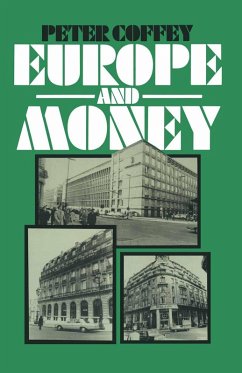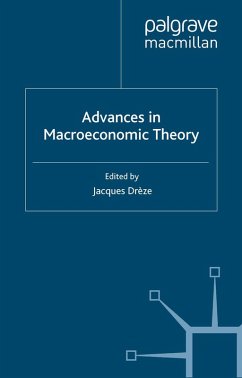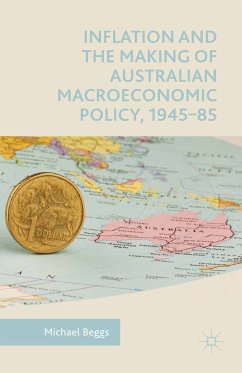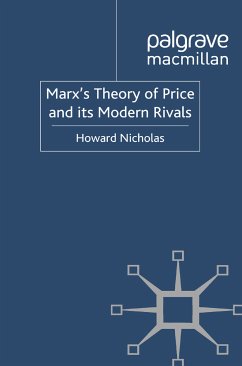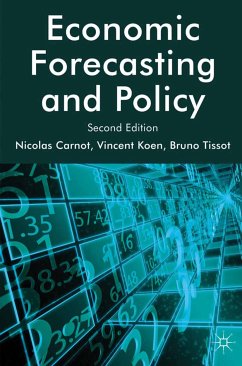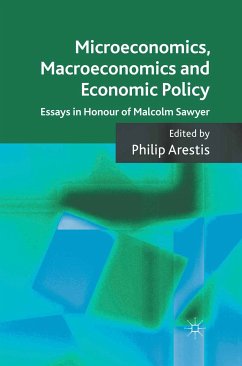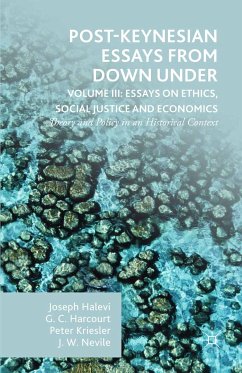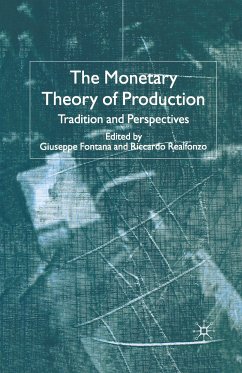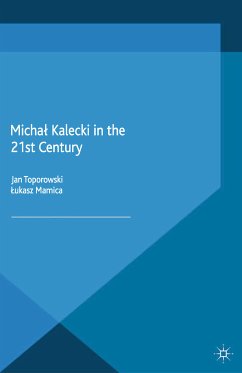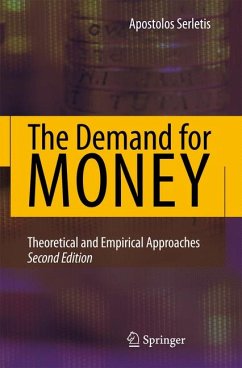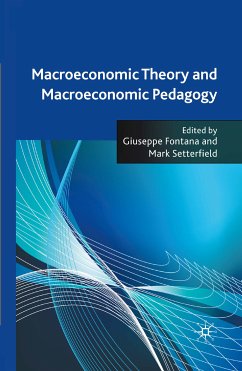
eBook, PDF
Macroeconomic Theory and Macroeconomic Pedagogy (eBook, PDF)

PAYBACK Punkte
20 °P sammeln!






This book aims to showcase and advance recent debates over the extent to which undergraduate macroeconomics teaching models adequately reflect the latest developments in the field. It contains 16 essays on topics including the 3-equation New Consensus model, extensions and alternatives to this model, and endogenous money and finance.
Dieser Download kann aus rechtlichen Gründen nur mit Rechnungsadresse in A, B, BG, CY, CZ, D, DK, EW, E, FIN, F, GR, HR, H, IRL, I, LT, L, LR, M, NL, PL, P, R, S, SLO, SK ausgeliefert werden.
PHILIP ARESTIS is University Director of Research, Cambridge Centre for Economics and Public Policy, Department of Land Economy, University of Cambridge, UK; Distinguished Adjunct Professor of Economics, Department of Economics, University of Utah, US; Senior Scholar, Levy Economics Institute, New York, US; Visiting Professor, Leeds Business School, University of Leeds, UK; and Professorial Research Associate, Department of Finance and Management Studies, School of Oriental and African Studies (SOAS), University of London, UK ROBERT J. BARBERA is an Economist at ITG, USA EMILIANO BRANCACCIO is Professor of Macroeconomics, University of Sannio, Italy WENDY CARLIN is a Professor at University College London, UK JAGJIT S. CHADHA is a Professor at the University of Kent, UK DAVID COLANDER has been the Christian A Johnson Distinguished Professor of Economics at Middlebury College, Middlebury, Vermont since 1982. In 2001-2002 he was the Kelly Professor of Distinguished Teaching at Princeton University, USA JESUS FERREIRO is Associate Professor in Economics at the University of the Basque Country, in Bilbao, Spain GIUSEPPE FONTANA is Professor of Monetary Economics at the University of Leeds (UK), Associate Professor at the Università del Sannio (Italy), Life Member Fellow at Clare Hall (University of Cambridge, UK), and Visiting Research Professor at the Centre for Full Employment and Price Stability (University of Missouri Kansas City, USA), and the Cambridge Centre forEconomic and Public Policy (University of Cambridge, UK) ECKHARD HEIN is a Senior Researcher at the Macroeconomic Policy Institute (IMK), Hans Boeckler Foundation, Duesseldorf, and an Adjunct Professor at Carl von Ossietzky University Oldenburg, Germany PETER HOWELLS is Professor of Monetary Economics in the Centre for Global Finance at the Bristol Business School, UK MARC LAVOIE is Professor in the Department of Economics at the University of Ottawa, where he started teaching in 1979. CASEY ROTHSCHILD received an AB in physics from Princeton University in 1999 and immediately began teaching economics at the Advanced Placement level at the Roxbury Latin School in Boston. After returning to school and earning his Ph.D. from M.I.T. in 2006, he joined the Economics faculty at Middlebury College as an assistant professor MALCOLM SAWYER is Professor of Economics, University of Leeds, U.K, and formerly Pro-Dean for Learning and Teaching for the Faculty of Business FELIPE SERRANO is Professor in Economics at the University of the Basque Country, in Bilbao, Spain. He is the head of the Department of Applied Economics V at the University of the Basque Country MARK SETTERFIELD is Professor of Economics in the Department of Economics at Trinity College, Hartford, Connecticut, USA Associate Member of the Cambridge Centre for Economic and Public Policy (Cambridge University, UK), and Senior Research Associate at the International Economic Policy Institute (Laurentian University,Canada) JOHN SMITHIN is Professor of Economics in the Department of Economics and the Schulich School of Business, York University, Toronto, Canada DAVID SOSKICE taught macroeconomics, econometrics and labour economics at Oxford from 1968 to 1990 before becoming Research Director at the Wissenschaftszentrum in Berlin (WZB), where he remained until 2007 working in collaboration with Peter Hall (Harvard) on Varieties of Capitalism (OUP, 2001) ENGELBERT STOCKHAMMER teaches at the Vienna University of Economics and Business Administration, Austria ROBERTO TAMBORINI teaches at the Department of Economics, Università di Trento, Italia ÉRIC TYMOIGNE received his Ph.D. from the University of Missouri-Kansas City, USA with a specialization in monetary theory and financial macroeconomics CHARLES L. WEISE is Associate Professor of Economics at Gettysburg College in Gettysburg, Pennsylvania, USA RANDALL L. WRAY is a Professor of Economics at the ,University of Missouri Kansas City, USA SIMON WREN-LEWIS is a professor at Oxford University and a Fellow of Merton College, UK
Produktdetails
- Verlag: Palgrave Macmillan UK
- Seitenzahl: 341
- Erscheinungstermin: 30. April 2016
- Englisch
- ISBN-13: 9780230291669
- Artikelnr.: 47536891
'The 2007/8 financial crisis starkly revealed the limitations of the three equation ''New Consensus'' macroeconomic model. This model abstracts by assumption from default and credit risk, and hence has no room for issues relating to financial intermediation and liquidity, a ''fair weather'' model. In this book the authors outline this and other drawbacks of the current mainstream model, and make a good start in amending this in ways which both come closer to reality and can be the basis for undergraduate teaching.' - Charles A.E. Goodhart, Emeritus Professor of Economics, and Member Financial Markets Group, London School of Economics (LSE, UK); former Bank of England's External Member, Monetary Policy Committee,UK
'All who teach
'All who teach
Mehr anzeigen
graduate macroeconomics will benefit from Fontana and Setterfield's efforts to broaden the scope of formal pedagogy and to incorporate Keynesian and Post Keynesian insights into a disciplined teaching framework.' - James K. Galbraith,
Professor at the Lyndon B. Johnson School of Public Affairs and at the Department of Government, University of Texas, at Austin; former Executive Director of the Joint Economic Committee, Congress of the United States, and guest scholar at the Brookings Institution, Washington, DC, USA
'Macroeconomic theory has developed rapidly in the last two decades, but undergraduate teaching and textbooks have not kept up. This timely book surveys approaches to improving pedagogy, focusing on a 3-equation model that is similar in spirit to cutting-edge macro theories but accessible to undergraduates. In addition to its theoretical appeal, the model is better than traditional textbook models for analyzing real-world economic fluctuations.' - Larry Ball, Professor of Economics, Johns Hopkins University, Baltimore, USA
Professor at the Lyndon B. Johnson School of Public Affairs and at the Department of Government, University of Texas, at Austin; former Executive Director of the Joint Economic Committee, Congress of the United States, and guest scholar at the Brookings Institution, Washington, DC, USA
'Macroeconomic theory has developed rapidly in the last two decades, but undergraduate teaching and textbooks have not kept up. This timely book surveys approaches to improving pedagogy, focusing on a 3-equation model that is similar in spirit to cutting-edge macro theories but accessible to undergraduates. In addition to its theoretical appeal, the model is better than traditional textbook models for analyzing real-world economic fluctuations.' - Larry Ball, Professor of Economics, Johns Hopkins University, Baltimore, USA
Schließen
Für dieses Produkt wurde noch keine Bewertung abgegeben. Wir würden uns sehr freuen, wenn du die erste Bewertung schreibst!
Eine Bewertung schreiben
Eine Bewertung schreiben
Andere Kunden interessierten sich für


